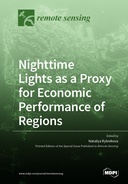Explore

Nighttime Lights as a Proxy for Economic Performance of Regions
0 Ungluers have
Faved this Work
Login to Fave
Studying and managing regional economic development in the current globalization era demands prompt, reliable, and comparable estimates for a region’s economic performance. Night-time lights (NTL) emitted from residential areas, entertainment places, industrial facilities, etc., and captured by satellites have become an increasingly recognized proxy for on-ground human activities. Compared to traditional indicators supplied by statistical offices, NTLs may have several advantages. First, NTL data are available all over the world, providing researchers and official bodies with the opportunity to obtain estimates even for regions with extremely poor reporting practices. Second, in contrast to non-standardized traditional reporting procedures, the unified NTL data remove the problem of inter-regional comparability. Finally, NTL data are currently globally available on a daily basis, which makes it possible to obtain these estimates promptly. In this book, we provide the reader with the contributions demonstrating the potential and efficiency of using NTL data as a proxy for the performance of regions.
This book is included in DOAB.
Why read this book? Have your say.
You must be logged in to comment.
Rights Information
Are you the author or publisher of this work? If so, you can claim it as yours by registering as an Unglue.it rights holder.Downloads
This work has been downloaded 130 times via unglue.it ebook links.
- 130 - pdf (CC BY) at Unglue.it.
Keywords
- arbitrary area representation
- artificial light-at-night (ALAN)
- attention-augmented CNN
- Boundaries
- Chongqing
- cross-sectional
- daytime satellite imagery
- DMSP
- DMSP-OLS
- Economic inequality
- Economic statistics
- Education inequality
- fine-grained GDP estimation
- functional urban areas (FUAs)
- GDP
- Human development
- intra-urban scaling
- Iran
- JCPOA
- kernel density estimation
- Luojia 1-01
- Luojia 1-01 satellite
- MNUACI
- multiple regression modelling
- n/a
- nightlight
- nighttime light
- nighttime light emissions
- nighttime lights
- NPP-VIIRS
- optimal threshold
- Population density
- population reorganization
- Reference, information & interdisciplinary subjects
- Research & information: general
- sanctions
- searching radius threshold
- Shadow economy
- spatial measurement
- spatial resolution
- spatiotemporal patterns
- street nodes
- Sustainable development
- thema EDItEUR::G Reference, Information and Interdisciplinary subjects::GP Research and information: general
- time-series
- urban area
- urban built-up area
- urban hotspot delineation
- urban remote sensing
- Urbanization
- VIIRS
- VIIRS imagery
- Zipf’s law
Links
DOI: 10.3390/books978-3-0365-3438-1Editions

